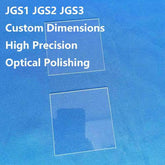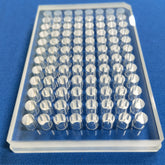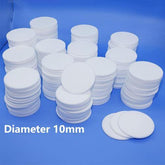The Functions of High Transmittance in Sapphire Glass Applications
Sapphire glass is a high-performance optical material characterized by a broad-range optical transmittance, rendering it highly suitable for diverse applications. Chemically composed of α-aluminum oxide (Al₂O₃), it possesses a single-crystal structure that confers exceptional optical properties. Within the visible light spectrum (wavelength ranging from 380 nm to 780 nm), sapphire glass exhibits a transmittance exceeding 85%, with certain high-grade products achieving rates beyond 90%. This high transmittance renders it an excellent candidate for optical instruments, precision measurement apparatus, and consumer electronics.
Sapphire glass exhibits broad transmission capabilities spanning from the ultraviolet to the infrared spectral regions. In the ultraviolet spectral range, transmittance increases substantially starting at the wavelength of 200 nm, reaching approximately 80% at the wavelength of 250 nm. This property renders it highly valuable for ultraviolet optical systems. Within the infrared spectrum, its transmission extends up to the wavelength of 5500 nm, while maintaining high transmittance within the 3000-5000 nm spectrum, establishing it as an exceptional candidate for infrared optical window applications. Notably, sapphire glass displays an absorption peak around the wavelength of 2800 nm, attributed to the absorption of lattice vibrations, which must be carefully accounted for in practical implementations.

The optical properties of sapphire glass are directly dependent on its manufacturing process. Sapphire crystals grown via the Heat Exchange Method (HEM) or Czochralski (CZ) method exhibit superior optical uniformity and enhanced transmittance. During processing, precision polishing and specialized coating techniques can further optimize optical performance. For example, through the deposition of anti-reflective coatings, the transmittance of sapphire glass in the visible spectrum can be elevated to exceed 95%. These treatments are particularly critical for applications including camera lenses, laser systems, and optical sensors.
Sapphire glass demonstrates exceptional optical stability in extreme environments, maintaining consistent transmittance across a temperature spectrum from -200℃ to 1000℃. This property renders it ideally suited for demanding applications including aerospace systems, deep-space exploration equipment, and high-temperature industrial monitoring. At high temperatures of 500℃, it exhibits a mere 2-3% decrease from its original transmittance that significantly outperforms conventional optical glasses. Furthermore, sapphire exhibits remarkable radiation resistance, maintaining optimal optical performance even when exposed to high-energy radiation conditions.
In laser technology, the broad transmission spectrum of sapphire establishes it as an ideal window material for various laser systems. Ranging from ultraviolet excimer lasers to mid-infrared laser sources, sapphire windows deliver consistent optical performance. Particularly in high-power laser applications, sapphire’s high thermal conductivity (approximately 40 W/(m·K)) and low absorption coefficient (<0.1% cm) enable reliable operation under extreme power densities while maintaining structural integrity.

Sapphire glass exhibits distinctive advantages in the fabrication of specialized optical components. Utilizing precision machining techniques, manufacturers can produce sapphire elements with complex geometries, including aspheric lenses, prisms, and irregular windows. These components are particularly valuable in ultraviolet lithography and extreme ultraviolet optical systems, where sapphire’s high transmittance and minimal fluorescence characteristics in the deep ultraviolet spectrum make it a preferred material choice.
In medical device applications, the high transmittance and biocompatibility of sapphire glass establish it as a critical material for endoscopes, laser surgical instruments, and medical sensors. Particularly in advanced medical imaging technologies, including infrared thermography and optical coherence tomography (OCT), sapphire optical components deliver superior image quality. Experimental results have demonstrated that medical devices incorporating sapphire windows achieve enhanced signal-to-noise ratios and improved diagnostic accuracy.
Sapphire glass occupies a pivotal role in modern optical applications owing to its broad optical transmission range, exceptional environmental stability, and outstanding mechanical properties. It serves as a key material across diverse fields, ranging from consumer electronics and scientific instruments to medical devices and aerospace optical systems.






